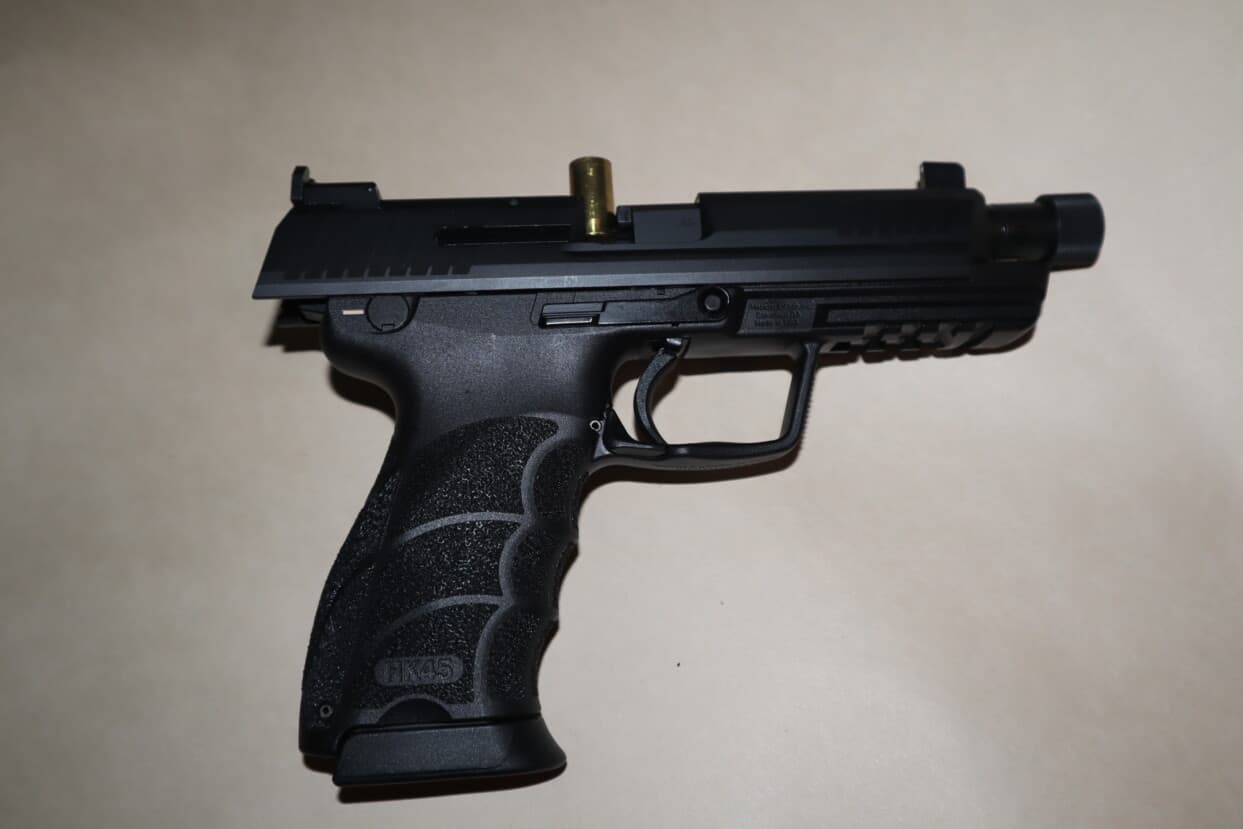Sooner or later your gun will jam. Semi-automatics are more finicky than revolvers, but their malfunctions are easier to clear.
Typically you can just “tap and rack” a semi-automatic to clear a jam: tap the base of the magazine to seat it properly, then rack the slide to clear the malfunction.
Here are the most common malfunctions and how to resolve them. Safety is paramount here, so don’t relax your standards while you address the problem. Treat every gun as loaded and point the muzzle only at things you are willing to destroy.
| Malfunction | Cause | Prevention | Solution | Skill Level |
| Misfire | Light Primer Strike | Gun Maintenance | Eject, Tap and Rack | Basic |
| Bad Primer | Switch Brands of Ammunition | Eject, Tap and Rack | Basic | |
| Double Feed | Two Rounds at Once | Gun Maintenance | Remove Magazine, Rack, Reinsert | Basic |
| Stove Pipe | Failure to Eject | Grip Firmly | Eject, Tap and Rack | Basic |
| Out of Battery | Misalignment | Don’t Ride the Slide | Eject, Tap and Rack | Basic |
| Squib | Not Enough Pressure | Switch Brands of Ammunition | Disassemble, Remove, Reload | Intermediate |
| Hang Fire | Weak Primer Ignition | Switch Brands of Ammunition | Wait 30 Seconds, Discard Round, Reload | Basic |
| Powder Not Burning | Switch Brands of Ammunition | Wait 30 Seconds, Discard Round, Reload | Basic |
Misfire
A misfire, also called a dud, is the failure of a cartridge to ignite when the primer or case rim has been struck by the firing pin. This can happen if there is a light primer strike or if the primer itself is bad.
Cease fire. Keep the pistol pointed in a safe direction just in case it finally detonates. Wait at least thirty seconds before opening the action. Once you have determined the round is not going to fire, eject the cartridge to examine the primer.
A normal indentation from the firing pin indicates bad primer. Discard the cartridge. A light indentation indicates a light primer strike. This round can still be used. If there is any doubt in your mind, toss it. Tap the base of the magazine to properly seat it, then rack the slide.
If you find yourself dealing with misfires frequently, buy a better grade of ammunition.
Double Feed
A double feed may occur if two cartridges enter the chamber at the same time. Lock the slide to the rear and remove the magazine for safety. Rack the slide repeatedly to clear the double feed. Reinsert the magazine and rack the slide again to chamber a round.
If your gun is double feeding often, have the extractor examined. The extractor is failing to take the spent round out of the chamber after the last shot. The old round is still in the chamber when the new round is removed from the magazine.
Stove Pipe Malfunction
The stove pipe malfunction occurs when a round fails to eject, leaving what looks like a stove pipe sticking out of top of the ejection port. Tap the magazine and rack the slide.
“Limp wristing” your gun means not holding it firmly enough. This allows too much movement and the gun doesn’t have a stable platform to allow the slide to reset. The force of the recoil is absorbed by your hand rather than providing the momentum needed to reset the position of the slide after the shot.
Out of Battery
If the slide and the frame of the gun are not aligned, you have an out of battery malfunction. If the round enters the chamber at a bad angle, it may not fully seat into the chamber, causing the slide not to advance fully. The slide will be hanging slightly over the grip rather than flush with its back edge.
Tap the magazine and rack the slide. You may also use the palm of your hand to push the slide back into place.
An out of battery malfunction is typically caused by the shooter “riding the slide.” When you rack the slide, be sure to let go as it goes back forward; otherwise you decrease the momentum of the forward movement of the slide and it lacks sufficient speed to stay in alignment.
Squib Load
Squib loads can be dangerous. They sound quieter than a normal shot. A squib load sticks in the barrel when there is not enough pressure behind it to eject the bullet when you fire.
The round lodges somewhere between the chamber and the muzzle, which could damage the gun if you try to shoot another round afterward. Unload and disassemble the gun, looking for the obstruction. Have your instructor help you with this.
Disassembly is the same process you will use to break it down when you clean the gun. Read our blog on how to clean a semi-auto. Use a wooden dowel of slightly less diameter than the chamber to poke the cartridge out through the closer end of the barrel. Discard the malfunctiong cartridge and reload. Tap and rack.
If you are finding multiple squib loads, switch to a better brand of ammunition. Squib loads should be rare. If you ever have a shot that sounds “off,” check the chamber. Squib loads have been known to explode the barrel of a gun if you don’t remove the squib before you shoot again.
Hang Fire
The most disconcerting malfunction is a hang fire. The shot sounds like it is late. Be especially careful with this one. A hangfire is a perceptible delay in the ignition of a cartridge after the primer or case rim has been struck by the firing pin.
This can be caused by a weak primer igntion or the powder not burning properly. Cease fire and keep the pistol pointed in a safe direction. Wait 30 seconds before racking the slide to remove the round. Discard the malfunctioning round and reload. Tap and rack.
If you experience hang fire malfunctions, switch to a better brand of ammunition.
Preventing Malfunctions
When you have a malfunction, keep safety foremost in your mind. If you have any doubt about how to fix it, consult an experienced shooter.
The best way to deal with a malfunction is to prevent it from happening in the first place. Use high-quality rounds and make sure that you have the right caliber rounds for the gun you have chosen.
Certain bullet shapes do not work as well. They jam into the feed ramp going into the chamber and get stuck. Bullets with rounded or cone-shaped ends typically work best in semi-autos. Full Metal Jacket or Semi-Jacketed Hollowpoints are ideal. See our blog that explains ammunition types in detail.
Older style lead-nose rounds with truncated cone shapes are problematic but are unlikely to be offered in a gun store; this is more of an issue for reloading your own ammunition.
If you use reloaded rounds, make sure you know the person who did the reloading because there is an art to getting the right mix of ingredients.
Clean your gun regularly to prevent fouling the chamber, which could cause malfunctions.
Hold your gun firmly when you shoot to avoid “limp-wristed” shooting. Failure to eject may result.
Stay alert when you shoot. If you notice your gun is malfunctioning frequently, obtain instruction to find out what is going wrong. Read our blog on the fundamentals of shooting to see if your skills could use improvement.
Pay special attention to the sound of the shot and the timing. If it doesn’t sound loud enough, stop shooting and follow the instructions above for a squib load. If the timing doesn’t seem right, follow the instructions for a hang fire. Don’t shoot if you aren’t sure.



1 thought on “How To Clear a Malfunctioning Semi-Automatic Pistol”
Comments are closed.